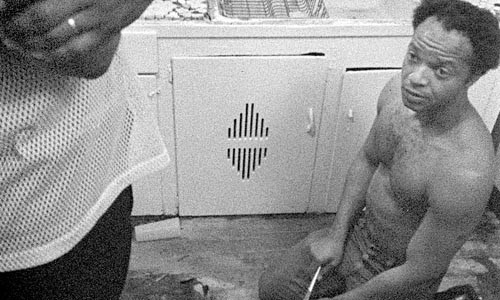Three decades late, a cinematic injustice has been righted: Charles Burnett's 1977 masterwork, Killer of Sheep, is available in movie theaters. The film, a quiet gut-punch depicting life in Watts, has been a critic's favorite for a generation. But the cost of clearing song rights for the soundtrack has kept it from commercial screenings (and home video).
Now audiences can see what they've been missing, which is at once completely on the surface and much more than meets the eye: one of the best American films ever about children, city life, the working class and the black experience, all at once.
As poignant as it is bracingly unsentimental, it's also a pretty fair piece of visual art. Shot for nickels, as the 33-year-old Burnett's thesis for UCLA film school, Killer of Sheep portrays a community in a gritty, deep-focus black and white that coats your hands with the dust of vacant lots and puts your feet on the asphalt of summer streets.
The first person we see is a boy being scolded -- told to be a man -- and in fact a key to Burnett's film lies in his recurring images of kids. These scenes at first appear incidental to the central story, about a melancholy slaughterhouse worker named Stan and his troubled relationship with his wife. The kids have rock fights, scuffle playfully, a tangle of limbs in Burnett's crowded frame. In vain, some boys team up to try to push an old rail car down a dead track; in an ecstatic passage late in the film, the camera watches from the ground as a half-dozen kids or more vault the gap between two three-story apartment buildings, silhouetted against the sky like birds.
Stan (Henry Gayle Sanders) has children of his own, including a moody adolescent son. Stan's daughter, who's about 6, receives one of the weirdest introductions in American cinema: Standing in the kitchen, silently watchful, she sucks her finger beneath an oversized Droopy Dog mask she wears through several scenes.
If Killer of Sheep seems desultory, though, think again. Even as Stan battles through his blues, his poverty, his sexual malaise and recruitment efforts by petty crooks, the kids are there, reflecting their community like a mirror, absorbing its chemistry like kidneys. Scenes of play typically end with some child or other getting hurt. In Burnett's Watts (where he grew up), the pain may not be mortal, but it's almost constant.
The relationship between Stan and his wife (Kaycee Moore) is heartbreaking. "Don't nothing ever make you want to smile?" she asks him. The film's most memorable passages include their unbearably tender living-room slow dance to Dinah Washington's "This Bitter Earth." But this narrative too echoes among the children, sometimes in ways as matter-of-factly poetic as they are unsettling. A later scene in which Stan and his daughter display their mutual affection, in full view of the wife he can hardly bear to touch, is followed by a sequence in which a pack of boys emerges from an oddly gynecological opening in an old building only to hurl dirt clods at a slightly older girl who's busy hanging laundry.
All of it informs Stan's story as a man who works too hard to surrender his dignity. "Man, I ain't poor! I give away things to the Salvation Army," he says. Meanwhile, repeated images of cars that won't start, or that break down on the road, reflect his struggle too.
Killer of Sheep has plenty of earthy humor -- like two crooks' pathetic efforts to steal a TV set. It also boasts a potent soundtrack -- worth every penny, maybe even a 30-year wait -- that's heavy on electric blues like Little Walter and Elmore James but ranges to Gershwin and Rachmaninoff.
Still, while Killer of Sheep is as stylistically assured as it is unique, it remains inescapably sorrowful. But it's beautifully, angrily, incisively so -- a stunning debut from a director whose subsequent features would include the little-seen My Brother's Wedding (1984), 1987's top-notch To Sleep With Anger (starring Danny Glover) and the wonderful 1996 TV movie Nightjohn.
In recent years, Killer of Sheep has screened in Pittsburgh perhaps twice, and then only on hard-traveled 16 mm prints. On a preview DVD, this new restoration by UCLA Film & Television Archive looked and sounded great. It should be revelatory to see in a theater, on 35 mm.
Yet for all the satisfactions it affords, Killer of Sheep depicts a society where measures of joy and hope are seldom undiluted. Note Burnett's frequent cuts, for instance, from scenes of kids playing to images of the slaughterhouse where Stan works. The film's darker jokes include doomed sheep receiving a soundtrack serenade addressed to "all the friends I've known."
Watch too how that slaughterhouse imagery progresses -- generally backward, from early sights of carcasses to late scenes depicting bolt guns to livestock heads. Any filmmaker could run that reverse, of course. But it took Burnett to simultaneously build his narrative to the point where the last thing we see is a provisionally revitalized Stan himself, displaying more enthusiasm than we've yet witnessed, urging the dumb beasts through the chute where the killing floor awaits. 
Starts Fri., June 22. Regent Square Theater















